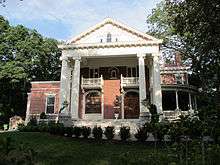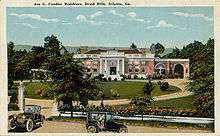Asa Griggs Candler
Asa Griggs Candler (December 30, 1851 – March 12, 1929) was an American business tycoon who in 1888 purchased the Coca-Cola recipe for US$1,750 from chemist John Stith Pemberton in Atlanta, Georgia. Candler founded The Coca-Cola Company in 1892 and developed it as a major company.[1][2][3][4][5]
Asa Griggs Candler | |
|---|---|
 | |
| 41st Mayor of Atlanta, Georgia | |
| In office 1917–1919 | |
| Preceded by | James G. Woodward |
| Succeeded by | James Lee Key |
| Personal details | |
| Born | December 30, 1851 Villa Rica, Georgia, U.S. |
| Died | March 12, 1929 (aged 77) Atlanta, Georgia, U.S. |
| Resting place | Westview Cemetery |
| Nationality | American |
| Spouse(s) | Lucy Elizabeth Howard
( m. 1878; died 1919) |
| Children | Charles Howard Candler, Asa Griggs Candler, Jr., Lucy Beall Candler Owens Heinz Leide, Walter T. Candler, William Candler |
| Occupation | Businessman |
| Known for | Founder of the Coca-Cola Company and philanthropist |
Prominent among civic leaders of Atlanta, Candler was elected and served as the 41st Mayor of the city, from 1916 to 1919. Candler Field, the site of the present-day Hartsfield-Jackson Atlanta International Airport, was named after him, as is Candler Park in Atlanta. As head of Coca-Cola, he built the Candler Building in Atlanta, as well as one in Kansas City (which became known as the Western Auto Building), a Candler Building (New York City), and one at what is now known as the Inner Harbor area of Baltimore, Maryland.
Family
Asa Griggs Candler was born on December 30, 1851 in Villa Rica, Georgia.[1] His parents were Martha and Samuel Charles Candler, a merchant and property owner.[6][7] His parents raised eleven children, including Asa and his brother Warren Akin Candler.[8] Samuel Charles Candler was a member of the legislature of South Carolina, and fought in the Creek War of 1836.[9]
- Children of Asa Griggs Candler
- Asa's eldest son, Charles Howard Candler (1878–1957), was chairman of the board of trustees of Emory University. His family estate was Callanwolde on Briarcliff Road in Druid Hills; it has been adapted for use as a fine arts center.
- The second son, Asa G. Candler, Jr. (1880–1953), eccentric, alcoholic, and depressed, became a real-estate developer, opening the Briarcliff Hotel. His Briarcliff mansion and estate—also on Briarcliff Road in Druid Hills—was adapted for use as an alcoholism rehab center, then a psychiatric hospital. It is now owned by Emory University and used as its Briarcliff campus. Asa Jr.'s menagerie of animals enabled a major expansion of Zoo Atlanta in the 1930s.
- Only daughter Lucy (1882–1962) married Henry Heinz, a banker and Kiwanis president. He was shot by a burglar in their mansion, Rainbow Terrace, in 1943.[10] Rumours persisted that a relative murdered him.[11] The widowed Lucy Candler Heinz later married cellist and conductor Enrico Leide. He founded a forerunner of the present Atlanta Symphony Orchestra.
- Third son Walter T. Candler (1885–1967) was a businessman, philanthropist, and horse sportsman. His Lullwater House and estate has been adapted for use as the residence of the Emory University President. Another portion is a park, and other land is the site of a Veterans Administration complex in Druid Hills. Walter T. Candler had one daughter.
- Youngest son William Candler (1890–1936), was the local financier of the Atlanta Biltmore Hotel and Biltmore Apartments. He was elected president of the Biltmore Corporation in February 1930, and was manager of the Biltmore Hotel. His mansion, named Rest Haven, is located on Springdale Road in Druid Hills.
Biography
Founder of Coca-Cola
A druggist in 1888, Asa Griggs Candler met John Stith Pemberton and was intrigued by a sweet, carbonated drink he had developed. Candler bought the Coca-Cola recipe from Pemberton, for an amount rumored to be $2,300.[7] The drink was derived from brewed coca leaves, as well as caffeine, carbonated water, and sugar. In 1892, he founded the Coca-Cola Company. The following year, he trademarked the brand and distributed the first dividends to the company's shareholders.[12]
By 1895, the company was distributing Coca-Cola nationwide in the United States. It first started exporting in 1899, to Cuba. Exports to Europe started two years later.[12] He also developed the famous "$1 contract" where he sold the rights to bottle Coca-Cola in the US for only one dollar.[13] At first, the company advertised Coca-Cola as a drink that relieved mental and physical fatigue, and cured headaches.[14]
In 1903, Candler decided to remove the cocaine component from the coca leaves before mixing them with the drink, and to sell the extracted cocaine to pharmaceutical companies.[15] In 1911, the company reached an annual advertising budget of $1 million. In 1915, the bottling company Root Glass Co. created the iconic Coca-Cola bottle.[12]
In 1916, after Candler was elected mayor of Atlanta, he ended his day-to-day management of the Coca-Cola Company. In 1917, the Coca-Cola company agreed to reduce by 50% the amount of caffeine in the drink.[14] In 1919 Candler gave most of the stock in The Coca-Cola Company to his children. They sold their shares to a consortium of investors led by Ernest Woodruff.[7]
Atlanta builder and mayor
In 1906 Candler completed what was then Atlanta's tallest building, the Candler Building.[16] It had intricately carved decorations and was 17 stories tall. It still stands at Peachtree and Auburn streets and is listed on the National Register of Historic Places, significant for its architectural detail and role as a company symbol.[17] In 1912 the Candler Building in New York opened.
In 1916, Candler was elected mayor of Atlanta (taking office in 1917). As mayor he balanced the city budget and coordinated rebuilding efforts after the Great Atlanta fire of 1917 destroyed 1,500 homes. He also made large personal loans in order to develop the water and sewage facilities of the city of Atlanta, in order to provide the infrastructure necessary to a modern city.
Candler was also a philanthropist, endowing numerous schools and universities (he gave a total of $7 million to Emory University,[18]) and the Candler Hospital in Savannah, Georgia. Candler had paid to relocate Emory University from Oxford, Georgia to Atlanta.[19]
Asa Candler suffered a stroke in 1926 and never recovered. He died on March 12, 1929 at Wesley Memorial Hospital in Atlanta, Georgia.[1][8] He is buried at Westview Cemetery on the west side of Atlanta.
Legacy
Atlanta
The Candler Field Museum in Williamson, Georgia, has been established to commemorate the original Candler Field, the first Atlanta airport.
Callan Castle, the Candler home in Inman Park, built from 1902 to 1904, still stands as a private home.
Candler's later mansion, built in 1916 at 1500 Ponce de Leon Avenue, Druid Hills, was later adapted for use as the John Chrysostom Melkite Greek Catholic Church.[20]
In 1922, he donated over 50 acres (200,000 m2) of his Druid Hills holdings to the City of Atlanta for what became Candler Park. That year he also sold the Central Bank and Trust.[8]
 Callan Castle in Inman Park.
Callan Castle in Inman Park. Candler mansion (built 1916) at 1500 Ponce de Leon Avenue in Druid Hills.
Candler mansion (built 1916) at 1500 Ponce de Leon Avenue in Druid Hills.- John Chrysostom Melkite Church, 2012.
Several Candler buildings were constructed as the Coca-Cola Company expanded in the early 20th century:
- Baltimore, Maryland - The Candler Building, located on the northeast corner of East Pratt Street and Market Place in eastern downtown, at the Inner Harbor, still bears his name. The brick industrial style building faces the waterfront of the basin of Baltimore Harbor, on the Northwest Branch of the Patapsco River. Used as a regional headquarters for the Coca-Cola Bottling Company, the structure was known for having brass door knobs engraved with "CC" for the company. Between the late 1930s and 1960, the building served as the national headquarters of the new Social Security Administration. This agency was authorized under the Social Security Act of 1935, one of the New Deal programs of President Franklin D. Roosevelt. By the 2000s, as the old waterfront area and municipal piers area were being redeveloped from commercial and industrial uses, the Candler Building was renovated for offices and some apartments/condos.
- In Kansas City, the Western Auto Building was known as the Coca-Cola Building or Candler Building when constructed for the Coca-Cola Company in 1914, and during its occupancy. It has been converted to loft condominiums.
- In New York City, the Candler Building is still in use.
See also
- Warren Akin Candler, for whom Emory's Candler School of Theology is named.
- Samuel Candler Dobbs
References
- "A.G. Candler, Maker Of Coca-Cola, Dies. Atlanta Philanthropist, 77, Had Been Ill in Hospital Founded by Him Since 1926. Amassed Large Fortune. Methodists Got $7,000,000. Other Millions Used to Help South In Times of Stress. Aided South With His Fortune. Succeeded in Company by Son. Gave $7,000,000 to Methodists". The New York Times. March 13, 1929.
- "Coca‑Cola History: History of Coca‑Cola Company: About Us". Coca-Cola Ireland. Archived from the original on May 25, 2016. Retrieved February 19, 2019.
- "Asa Candler: The Man Behind Coca-Cola's Pop". The Coca-Cola Company. Archived from the original on August 24, 2015. Retrieved February 19, 2019.
- "Asa Candler Purchases The Coca-Cola Company". The Coca-Cola Company. Archived from the original on July 20, 2014. Retrieved February 19, 2019.
- "When Was The Coca-Cola Company Founded? | FAQ". The Coca-Cola GB. Archived from the original on March 19, 2018. Retrieved February 19, 2019.
- Bonner, James C. (April 2010). Georgia's Last Frontier: The Development of Caroll County. ISBN 9780820335254.
- Amit Agarwal. "The Fizzy Empire Of Asa Griggs Candler". Marketingcrossing.com. Retrieved July 17, 2019.
- "Asa Candler (1851-1929)". Georgiaencyclopedia.org. Retrieved July 17, 2019.
- "Coca-Cola Candler". Time.com. October 11, 1926. Retrieved July 17, 2019.
- "Husband of Coca Cola Heiress is Slain by Burglar", Paineseville Telegraph, September 29, 1943
- Mark Pendergrast, For God, Country and Coca-Cola, p.133
- "Un vistazo por la vida de Coca-Cola" [A glimpse through the life of Coca-Cola] (in Spanish). Elmundo.es. January 27, 2000. Retrieved July 25, 2019.
- David B. Gracy (January 1973). "Georgia Archive I" (2). S2CID 154062961. Cite journal requires
|journal=(help) - "Anti Smoking Essay". paperap.com. June 20, 2019. Retrieved July 25, 2019.
- Ray Sturgess (December 23, 2000). "Freud, Sherlock Holmes and Coca Cola: the cocaine connection". Pharmaceutical-journal.com. Retrieved July 25, 2019.
- Kemp, Kathryn W. (September 3, 2002). "Asa Candler (1851-1929)". New Georgia Encyclopedia. Georgia Humanities Council. Retrieved January 16, 2009.
- Candler Building—Atlanta: A National Register of Historic Places Travel Itinerary
- "Coca-Cola Founder; Philanthropist; Emory Board Chair". Emory.edu. Retrieved July 17, 2019.
- Nikhil Deogun (October 20, 1997). "Atlantans Taste the Fruits Of Goizueta's Sweet Labors". Wsj.com. Retrieved July 25, 2019.
- "Candler Mansion". St. John's Chrysostom Melkite Church. Archived from the original on November 14, 2007. Retrieved January 16, 2009.
Before all of this present and holy utilization of this place, this mansion was formerly the home of Asa Candler
External links
- Stuart A. Rose Manuscript, Archives, and Rare Book Library, Asa Griggs Candler Papers
- Stuart A. Rose Manuscript, Archives, and Rare Book Library, Candler Family Papers
Further reading
| Wikimedia Commons has media related to Asa Griggs Candler. |
- Kemp, Kathryn W. (2002). God's Capitalist: Asa Candler of Coca-Cola. Macon, GA: Mercer University Press. ISBN 978-0-86554-782-7. OCLC 48944373.
- Allen, Frederick (1994). Secret Formula: How Brilliant Marketing and Relentless Salesmanship Made Coca-Cola the Best-Known Product in the World. New York: HarperBusiness. ISBN 978-0-88730-672-3. OCLC 30109538.
- Candler, Charles Howard (1950). Asa Griggs Candler. Georgia: Emory University. OCLC 1880574. Archived from the original on November 4, 2005.
- Charles Howard Candler (1950). Emory University (ed.). Asa Griggs Candler.
| Preceded by James G. Woodward |
Mayor of Atlanta 1917–1919 |
Succeeded by James L. Key |
